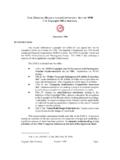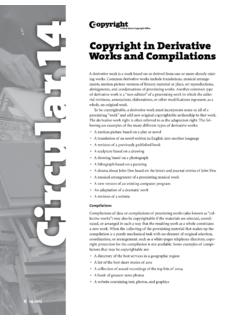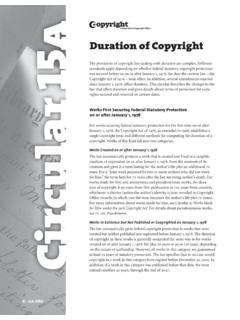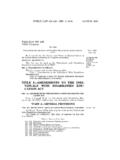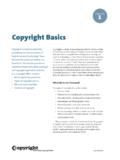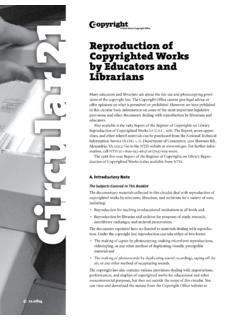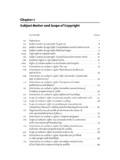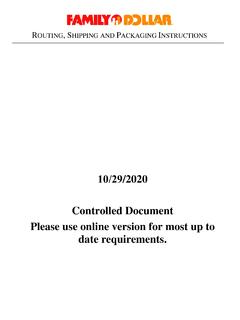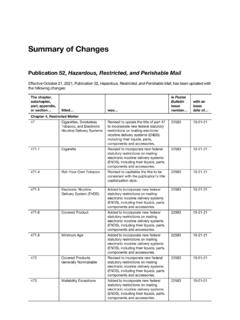Transcription of Circular 56 Copyright Registration for Sound Recordings
1 56 This Circular provides general information about the require-ments for registering Sound Recordings with the Copy-right Office. For specific information about this topic, see chapter 800 of the Compendium of Copyright Practices, Third is a Sound Recording?The Copyright Act defines Sound Recordings as works that result from the fixation of a series of musical, spoken, or other sounds but not including sounds accompanying a motion picture or other audiovisual work. Generally, a Sound recording is a recorded performance, often of another work. A Sound recording must be fixed, meaning that the sounds must be captured in a medium from which they can be perceived, reproduced, or otherwise communicated. The author may fix the sounds in a digital track, disk, tape, or other examples of Sound Recordings include an audio recording of: A person singing a song or playing a musical instrument.
2 A person reading a book or delivering a lecture. A group of persons hosting a podcast or performing a radio play. A person speaking, a dog barking, a bird singing, wind chimes ringing, or other sounds from the natural world (assuming the recording contains a sufficient amount of production authorship).A Sound recording typically includes the contributions of the parties whose performance is captured in the recording and the parties who captured and processed those sounds to make the final recording. Short Sound Recordings may lack A Sound recording is generally a recorded performance, often of another work. It must be fixed captured in a medium from which it can be perceived, reproduced, or otherwise communicated in a digital track, disc, tape, or other format. This Circular introduces legal concepts and Registration issues related to Sound Recordings .
3 It covers Distinction between Sound Recordings and other works Completing an application Deposit requirements Registering multiple Sound Recordings Scope of Copyright protectionCopyright Registration forSound RecordingsCopyright Registration for Sound Recordings2a sufficient amount of authorship to warrant Copyright protection, just as words and short textual phrases are not copyrightable. Sound Recordings captured by purely mechanical means without originality of any kind also lack a sufficient amount of authorship to warrant Copyright Recordings Distinguished from Underlying Creative WorksSound Recordings often contain other separate copyrightable creative works, such as songs, plays, lectures, or readings. The Copyright in a Sound recording covers the recording itself. It does not cover the music, lyrics, words, or other underlying content embodied in that recording.
4 For example, the song Rolling in the Deep authored by Adele and Paul Epworth and a recording of Aretha Franklin singing Rolling in the Deep are two distinct works. The underlying music and lyrics are a musical work, and a recording of an artist performing that song is a Sound recording. This Circular focuses on Registration issues involving Sound Recordings . It does not address registra-tion of the music, lyrics, or other content that may be embodied in the recording itself. For informa-tion on registering a song, book, or other content that may be embodied in a Sound recording, see Copyright Registration for Musical Compositions ( Circular 50) and chapter 700 of the Compendium. For information on registering a Sound recording together with the content embodied in that recording, see Copyright Registration of Musical Compositions and Sound Recordings ( Circular 56A).
5 Sound Recordings Distinguished from the Sounds Accompanying a Motion PictureThere is a legal distinction between a Sound recording and the soundtrack for a motion picture or other audiovisual work. The Copyright Act states that sounds accompanying a motion picture or audiovisual work are not Sound Recordings . These types of sounds are considered part of the motion picture or audiovisual examples of works that do not qualify as Sound Recordings include: The soundtrack for a cartoon, documentary, or major motion picture. The soundtrack for an online video, music video, or concert video. A musical performance during a scene or during the credits for a motion Recordings Distinguished from PhonorecordsA Sound recording is not the same as a phonorecord. A phonorecord is the statutory term for a physical object that contains a Sound recording, such as a digital audio file, a compact disc, or an LP.
6 The term phonorecord includes any type of object that may be used to store a Sound recording, including digital formats such as .mp3 and .wav Sound RecordingsA derivative Sound recording is an audio recording that incorporates preexisting sounds, such as sounds that were previously registered or published or sounds that were fixed before February 15, 1972. The preexisting recorded sounds must be rearranged, remixed, or otherwise altered in sequence Copyright Registration for Sound Recordings3or character, or the recording must contain additional new sounds. The new or revised sounds must contain at least a minimum amount of original Sound recording of derivative Sound Recordings include: A mashup comprising tracks and sounds from multiple sources. Additional tracks added to a previously published changes or processes, such as a change in format, declicking, or noise reduction, gener-ally do not contain enough original authorship to warrant a Sound RecordingTo register a claim to Copyright in a Sound recording, you must submit the following to the Copyright Office: (1) a completed application form; (2) a nonrefundable filing fee; and (3) the required deposit of your work.
7 This Circular highlights some common issues in registering a Sound recording with the Copyright Office. For more guidance in registering a Sound recording, see chapter 800, section of the Compendium. For general Registration issues, see Copyright Registration ( Circular 2).Completing the ApplicationWhen completing an online application, the Copyright Office offers the following of Work When you begin an application, select the Sound Recording option on the Type of Work screen. The questions you encounter when filling out the application are based on the choice you make at the beginning of the application. If you select the wrong option you will need to start Provide the title exactly as it appears on the work Publication occurs when phonorecords of a work are distributed to the public by sale, transfer of ownership, or by rental, lease, or lending.
8 Offering to distribute phonorecords to a group of persons for the purpose of further distribution or publicly performing the work also constitutes publication. Simply performing a Sound recording publicly does not constitute publication. If the work has not been published, state that the work is unpublished. If the work has been published, give the month, day, and year that phonorecords were first dis-tributed to the public or first offered to a group of persons for further distribution or public The author of a Sound recording is the performer featured in the recording and the producer who captured and processed the sounds that appear in the final Registration for Sound Recordings4 If the performer or producer created the Sound recording during the course of his or her employment under a typical employment relationship, then the Sound recording is a work made for hire, and the employer is the author of the Sound recording.
9 If the performer or producer created the Sound recording for a third party as a compilation or contribution to a collective work, and if the parties agreed in writing that the Sound recording will be a work made for hire, then the third party is the author of the more information on works made for hire, see Works Made for Hire ( Circular 30).Type of Authorship When registering a Sound recording, check the box for Sound Recording When registering artwork, photographs, or text of liner notes, include a brief statement to that effect in the Other field. When registering a compilation or a collective work (see below), state compilation of Sound Recordings in the Other of Claim When registering a derivative Sound recording, identify the preexisting material in the mate-rial excluded field and identify the new material in the new material included field.
10 If the preexisting material has been registered with the Copyright Office, include the Registration number and the Deposit Copies of the WorkTo register your Sound recording, you must submit the work to the Copyright Office. Once a deposit has been submitted, it becomes part of the public record and cannot be registering a Sound recording that is unpublished or published solely in a digital form, the Copyright Office strongly encourages you to submit the deposit as a digital file uploaded through the online Registration system. Do not also submit a physical phonorecord, such as a CD, flash drive, or other physical storage device. Each file must be uploaded in an acceptable file format and each uploaded file must not exceed 500 MB in you are registering a Sound recording published in a physical format, such as a compact disc or LP, submit the work in the physical format, even if there is a corresponding digital version.

